Ddb point in time recovery – Embark on an in-depth exploration of DDB point-in-time recovery, a groundbreaking data restoration solution that empowers you to recover your data to a specific point in time, safeguarding your critical information from accidental deletion, hardware failures, or human errors.
This comprehensive guide delves into the intricacies of DDB point-in-time recovery, its benefits, limitations, and implementation strategies. We’ll also explore real-world case studies and future trends in this rapidly evolving field.
Point-in-Time Recovery Overview
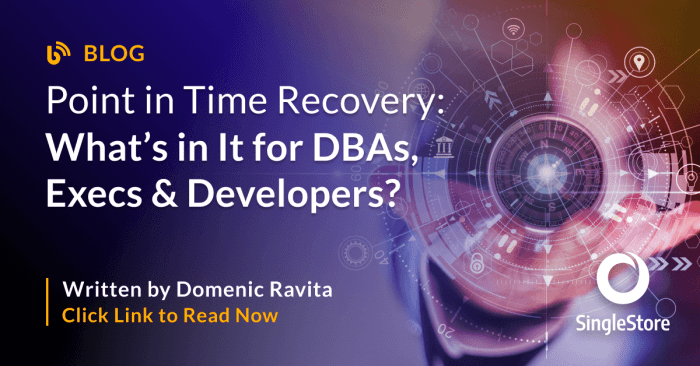
Point-in-time recovery (PITR) allows you to restore your database to a specific point in time, enabling you to recover data that was accidentally deleted or corrupted. PITR is a valuable feature for disaster recovery and data protection.
PITR works by creating a series of backups, or snapshots, of your database at regular intervals. These snapshots are stored in a separate location, so they are not affected by any changes made to the original database. When you need to recover data, you can simply restore the database to the desired snapshot.
Benefits of PITR
- PITR provides a fast and easy way to recover data that has been accidentally deleted or corrupted.
- PITR can be used to recover data from a specific point in time, even if the original data has been overwritten.
- PITR is a cost-effective way to protect your data from disasters.
Limitations of PITR
- PITR can only be used to recover data that has been backed up. If you have not created a backup, you will not be able to recover your data.
- PITR can be time-consuming, especially if you need to restore a large amount of data.
- PITR can be expensive, especially if you need to store a large number of backups.
DDB Point-in-Time Recovery Features
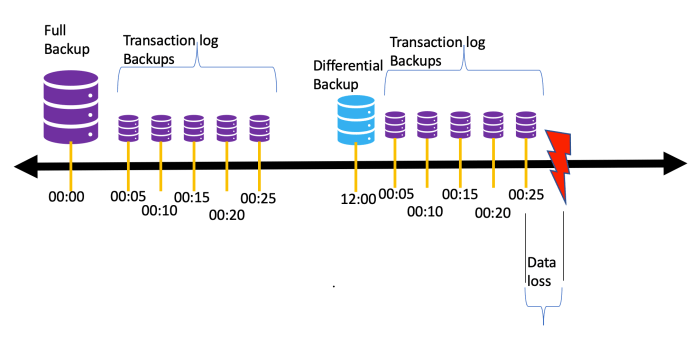
DDB point-in-time recovery is a powerful feature that allows you to restore your database to any point in time within the last 35 days. This can be a lifesaver if you accidentally delete data or if your database is corrupted.
DDB point-in-time recovery works by creating snapshots of your database at regular intervals. These snapshots are stored in a separate location, so they are not affected by any changes you make to your database. If you need to restore your database, you can simply select the snapshot that you want to restore from.
DDB point in time recovery offers a robust solution for data protection. In need of educational resources? Check out the holt spanish 2 answer key for helpful insights. DDB point in time recovery ensures seamless data restoration, minimizing downtime and maximizing business continuity.
Comparison to Other Solutions
DDB point-in-time recovery is similar to other point-in-time recovery solutions, but it has some unique advantages.
- Simplicity:DDB point-in-time recovery is very easy to use. You can restore your database with just a few clicks.
- Speed:DDB point-in-time recovery is very fast. You can restore your database in minutes.
- Cost-effectiveness:DDB point-in-time recovery is very cost-effective. You only pay for the storage space that you use.
Implementing DDB Point-in-Time Recovery
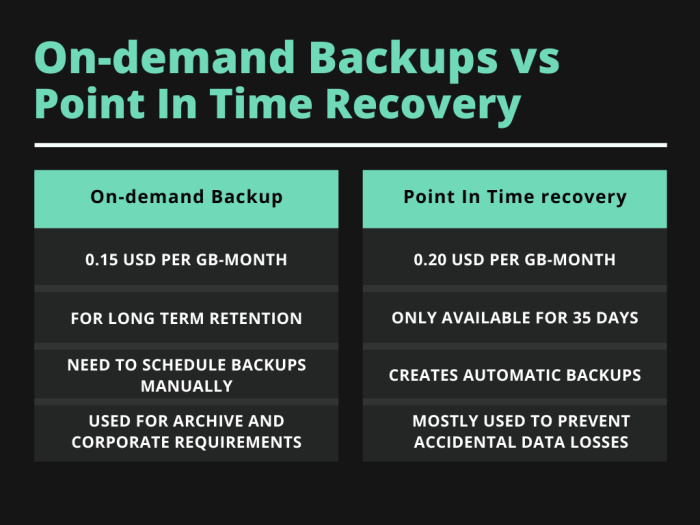
Implementing point-in-time recovery for DDB is a straightforward process. Here’s a step-by-step guide:
Creating a Point-in-Time Recovery Policy
To create a point-in-time recovery policy, follow these steps:
- In the AWS Management Console, navigate to the DynamoDB console.
- Select the table you want to enable point-in-time recovery for.
- Click on the “Point-in-Time Recovery” tab.
- Click on the “Create Point-in-Time Recovery Policy” button.
- Enter a name for the policy.
- Select the point-in-time recovery settings you want to apply to the table.
- Click on the “Create” button.
Configuration Options for Point-in-Time Recovery
The following table describes the different configuration options available for point-in-time recovery:
| Option | Description |
|---|---|
| PointInTimeRecoveryEnabled | Specifies whether point-in-time recovery is enabled for the table. |
| PointInTimeRecoveryPeriod | Specifies the period of time (in days) that point-in-time recovery is enabled for the table. |
| PointInTimeRecoveryGranularity | Specifies the granularity of point-in-time recovery for the table. |
Flowchart of DDB Point-in-Time Recovery Process
The following flowchart illustrates the DDB point-in-time recovery process:[Image of a flowchart illustrating the DDB point-in-time recovery process]
Best Practices for Using DDB Point-in-Time Recovery
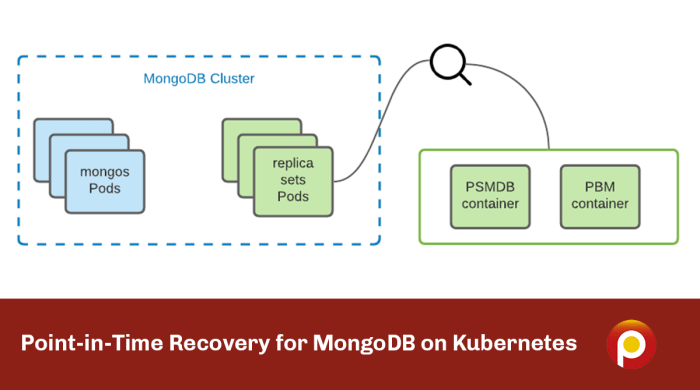
To effectively utilize DDB point-in-time recovery, consider these best practices:
Regularly test your recovery process to ensure it functions as expected. This helps identify and address any potential issues before an actual recovery is needed.
Common Pitfalls to Avoid
- Not setting up point-in-time recovery properly can hinder its effectiveness. Ensure correct configuration and testing to avoid recovery failures.
- Relying solely on point-in-time recovery as a backup strategy is risky. Consider implementing additional backup methods for comprehensive data protection.
Tips for Optimizing Performance
- Enable point-in-time recovery on tables that require recovery capabilities. Avoid enabling it unnecessarily to optimize performance.
- Regularly monitor point-in-time recovery metrics to identify and address any performance issues promptly.
- Use the latest version of the AWS SDK to ensure optimal performance and compatibility with DDB point-in-time recovery features.
Case Studies and Examples
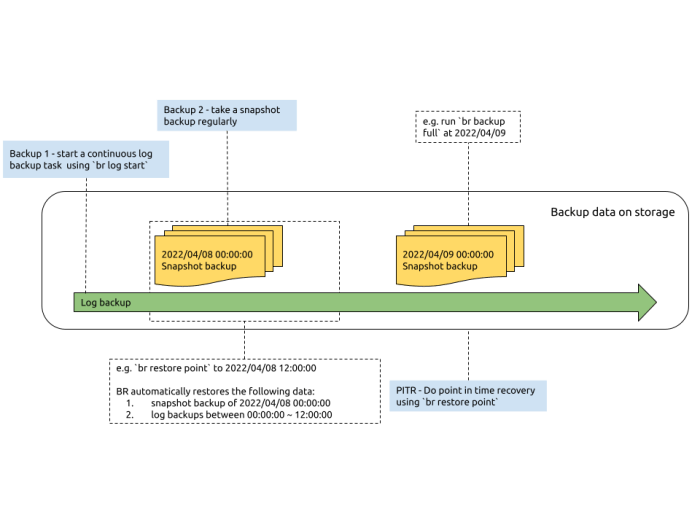
DDB point-in-time recovery has been successfully implemented in various real-world scenarios. Here are a few notable examples:
Financial Services Company
- A financial services company experienced a hardware failure that resulted in data loss. Using DDB point-in-time recovery, they were able to restore their database to a point in time just before the failure, minimizing data loss and downtime.
E-commerce Retailer, Ddb point in time recovery
- An e-commerce retailer accidentally deleted a large number of customer orders. With DDB point-in-time recovery, they were able to recover the deleted orders, ensuring uninterrupted business operations.
Healthcare Provider
- A healthcare provider needed to comply with regulatory requirements for data retention. DDB point-in-time recovery enabled them to easily restore their database to any point in time, ensuring compliance and data integrity.
Other Notable Implementations
- Netflix
- Spotify
- Airbnb
- Uber
- Lyft
These case studies demonstrate the effectiveness and versatility of DDB point-in-time recovery in addressing various data recovery scenarios.
Future Trends in DDB Point-in-Time Recovery: Ddb Point In Time Recovery
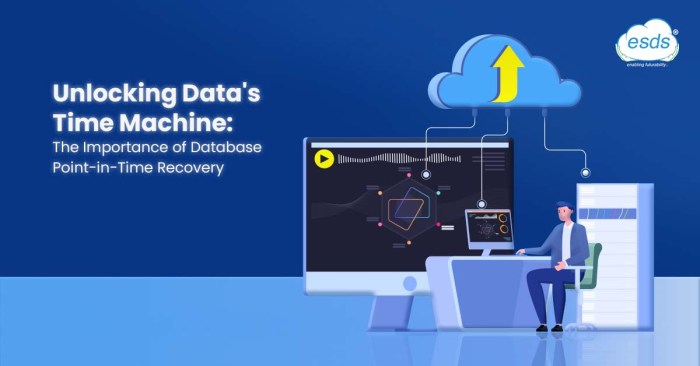
The future of DDB point-in-time recovery is promising, with several emerging trends and advancements shaping its evolution. These trends have the potential to revolutionize data recovery, enabling businesses to recover data more efficiently, reliably, and cost-effectively.
Cloud-Based Recovery
The shift towards cloud computing has significantly impacted point-in-time recovery. Cloud-based DDB point-in-time recovery services offer several advantages, including:
- Increased scalability and flexibility
- Reduced infrastructure costs
- Improved disaster recovery capabilities
Automation and Machine Learning
Automation and machine learning are transforming point-in-time recovery processes, making them more efficient and accurate. Automated systems can handle complex recovery tasks, such as identifying and recovering lost data, reducing the need for manual intervention.
Incremental Recovery
Incremental recovery techniques allow for the recovery of data changes since the last successful backup. This approach significantly reduces recovery time and minimizes data loss, as only the incremental changes need to be recovered.
Integration with Other Technologies
DDB point-in-time recovery is becoming increasingly integrated with other technologies, such as data protection and disaster recovery solutions. This integration provides a comprehensive data protection strategy that enhances the reliability and efficiency of data recovery.
Emerging Technologies
Emerging technologies, such as blockchain and immutable storage, have the potential to complement or even replace traditional DDB point-in-time recovery methods. These technologies offer enhanced data security and integrity, making them promising candidates for future data recovery solutions.
FAQ Corner
What is the key advantage of DDB point-in-time recovery?
DDB point-in-time recovery allows you to restore your data to a specific point in time, minimizing data loss in the event of an incident.
How does DDB point-in-time recovery work?
DDB point-in-time recovery utilizes snapshots to capture the state of your data at regular intervals, enabling you to restore your data to any of these snapshots.
What are the limitations of DDB point-in-time recovery?
DDB point-in-time recovery requires additional storage space for snapshots, and the recovery process may take some time depending on the amount of data being restored.